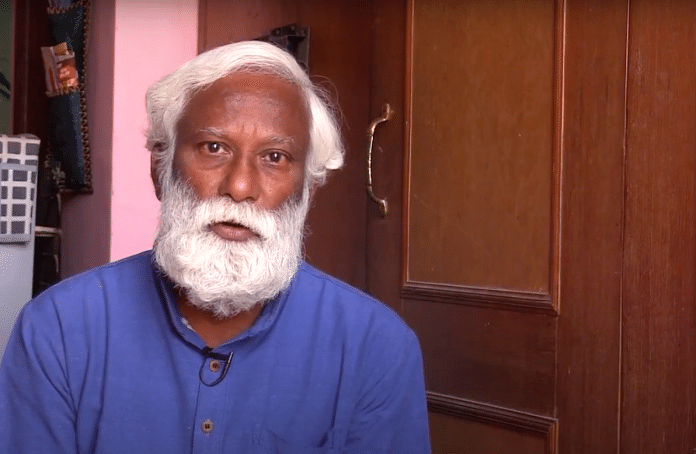India is losing many important social revolutionaries to the devastating Covid-19 pandemic. One of them is prolific writer-actor and folk singer Vijay Vairagade, popularly known as Vira Sathidar. A lifelong anti-caste activist, Sathidar, who succumbed to Covid-19 in Nagpur on 13 April, spent 40 years of his life deploying theatre against caste injustices, and heading the convener post of Indian People’s Theatre Association.
But in October 2020, Sathidar found himself in the National Investigation Agency’s supplementary chargesheet in the Bhima Koregaon case, which contained a list of activists whom the agency branded as ‘Urban Naxal’. As a result, Sathidar was subjected to constant harassment.
Sathidar used to run a bi-monthly magazine Vidrohi, whose publication he had to postpone several times due to cash crunch. Through his protests, writings, and street performances, Sathidar carved a rich legacy of caste-class resistance. He believed that songs and street theatre are the weapons against the brahminical and capitalist forces.
In an interview with Indian Cultural Forum, Sathidar mentioned how he grew up experiencing layers of casteism and recounted his childhood memories of the Republican Party of India allying with socialists and Communists in their fight for people’s land rights. He was also inspired by the songs of Ambedkarite singers like Vamandada Kardak, Nagorao Patankar, Govindrao Mhashilkar and Laxman Rajguru.
Also read: How Instagram reels is a mirror to modern casteism in India
Activism through art
Many stalwarts of India’s Dalit movement have found cultural assertion to be a prominent tool in the fight against the domination and suppression of the ruling caste and class. Through their resistance, several cultural artists have acquired a crucial role in people’s lives and strengthened the fight against the hegemonic brahminical system. This has helped create a robust cultural space for Dalits and other oppressed communities to awaken anti-caste and anti-class conscience among the masses.
Activists and theatre personalities from the oppressed communities have rarely got the chance to perform their politics through cinema. Vira Sathidar was among the most deserving ones but the Marxist-Ambedkarite activist could do it prominently only once, in the role of Narayan Kamble in Chaitanya Tamhane’s National Award-winning film Court. The 2014 film highlights injustices and the plight of the oppressed community in India’s legal system. Court not only shows the systemic exploitation of the people that Narayan Kamble, a Dalit protest singer, confronts, but it also plays out as the reel-life version of its lead actor.
In its obituary, The New York Times quotes Sathidar: “He [Kamble] has worked at a factory, I have worked at a factory… He writes articles, I also write articles. He is an editor, I am also an editor. He works at a union, I also work at a union. He sings songs, I also sing songs. He goes to jail; I have also been to jail many times. His house is raided, my house is also raided. What he is showing is my life.” Court also inspired Sathidar to dream to be a film writer and a filmmaker.
Also read: A Dalit lead who isn’t honour killing or inter-caste love victim. It takes a Neeraj Ghaywan
A role model for young activists
Sathidar, a school dropout, was forever an artist who went through a life of poverty while living in Nagpur’s Jogi Nagar — also known as Hamal Patti, an area of coolies — where he worked in a factory most of his life. Since his early years, Sathidar was influenced by Ambedkarite ideology.
His life experiences and cultural environment shaped his anti-caste, anti-class consciousness. He started to register his resistance through street performances. Through his art, he tried to subvert traditional cultural performances such as gondhal, gaulan, tamasha, lavani, shayari to weave oppression, poverty and Ambedkarite thought through these performative styles. His activism mainly revolved in and around the Vidarbha region in Maharashtra.
Sathidar wanted to see the culturalisation of cinema. As a strong opponent of the multiplex culture, Sathidar had a dream to popularise cinema of the janta (people’s cinema) against the capital-driven mainstream cinema, which is devoid of any connection with the reality of oppressed people’s lives.
The legacy of Vira Sathidar leaves us with many lessons. If you are born in a downtrodden community, fighting and activism for your people and the self come naturally to you. It becomes an inevitable part of your life. Whatever ability of resistance one builds and wherever one gets an opportunity to perform their assertion, one exercises it to form casteless and classless society.
Sathidar, as a defender of human rights, was fighting on the ground where caste works minutely and systematically. The Ambedkarite community at large is generally reluctant to accept the politics of a person with Marxist-Ambedkarite leanings, but Vira Sathidar was confidently and constantly navigating through Ambedkarite as well as Marxist circles. What we have seen in the film Court is a macro image of Sathidar; the real inspiration oppressed communities can take is by reading and understanding his micro image visible in his work, movement, protest, and art. It is the future that will decide how Sathidar’s life and work are received and remembered by the young generation of human rights activists.
Prashant Ingole is a doctoral candidate in Humanities and Social Sciences at the Indian Institute of Technology, Gandhinagar. His dissertation is titled “Representation and Lived Experience(s) of Dalits in Visual and Verbal Mediums. Views are personal.
(Edited by Prashant Dixit)



